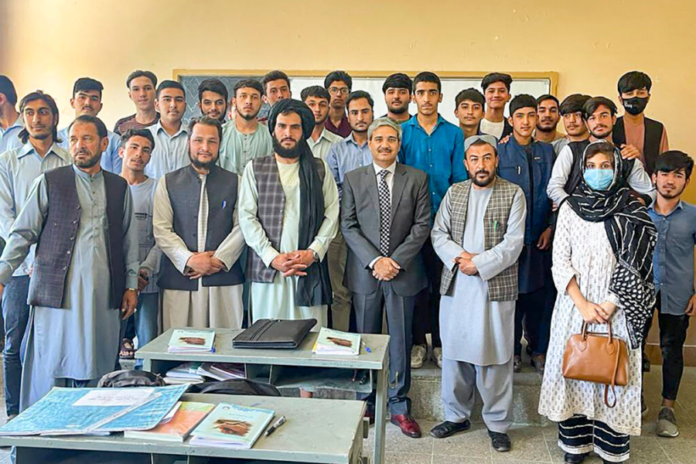At a time when most people were ignorant of statecraft and strategy, many centuries ago, Kautilya told his disciple Chandragupta Maurya that his kingdom’s near neighbor would always be its enemy. However, the opponent’s enemy will be a friend, so this fundamental principle must be kept in mind when making any strategic decisions. India’s current approach to the Taliban rulers of Afghanistan seems to reflect this principle.
It appears that India was thinking along these same lines this week when a series of fascinating photos from Afghanistan appeared in the media. Amir Khan Muttaqi, the foreign minister of the Taliban, met with a delegation from India headed by JP Singh, joint secretary in the Ministry of External Affairs, in Kabul.
Also Read: The unholy nexus tricking Indians to fight for Russia in Ukraine war
The UN Assistance Mission to Afghanistan representatives, former president Hamid Karzai, and a few members of the business community were also met by the Indian team. Following the Taliban’s 2021 comeback to power, this was India and the group’s second public meeting. The first interaction with the public occurred in 2022 when Joint Secretary Singh also met Foreign Minister Muttaqi of the Taliban.
Since the Taliban retook control of the nation three years ago and established the Islamic Emirate of Afghanistan, India and the new authorities have had a very solid diplomatic relationship. India’s foreign policy elite has frequently used historical precedent and links to civilisation as justifications for keeping close ties with Kabul. Not until Prime Minister Narendra Modi pushed the Taliban to establish a national unity government.
Despite not having granted diplomatic recognition to the state established by the Taliban, India has persisted in interacting with all parties involved in Afghanistan, including the Taliban.
A significant portion of this involvement is devoted to providing humanitarian relief to the Afghan people, which is being managed by a technical team that India has been posting since June 2022.
India’s assistance to Afghanistan included food grains to help during an extraordinary food scarcity, medical supplies including Covid-19 vaccines, and ongoing support for over 500 projects in vital areas like electricity, water supply, road connectivity, healthcare, education, agriculture, and capacity building.
Notably, prior to the fall of the previous administration and the Taliban’s reappearance in power, India had already invested $3 billion in Afghanistan. India has persisted in supporting its programs in the nation on humanitarian grounds even after the Taliban made a comeback.
In addition, India made a bold political move by engaging with the Taliban. An Indian delegation attended a conference of the Taliban-organized Regional Cooperation Initiative in January of this year.
The meeting was attended by envoys and representatives of twelve nations, including China, Pakistan, Russia, Indonesia, and Uzbekistan. Although no nation has officially acknowledged the Taliban as the country’s legal government to yet, a number of nations have acknowledged diplomatic representation from the Taliban and vice versa, effectively endorsing the new administration.
Conversely, India has only kept a technical team in the nation up to this point. The Afghan embassy in India was actually in danger of collapsing when about 28 diplomats loyal to the former government departed the country and declared the mission would be shutting permanently. Since then, however, the Afghan embassy in India has been run by employees of the Afghan consulates in Hyderabad and Mumbai.
Even though there isn’t an official connection between the Taliban and the remaining diplomats, Sher Mohammad Stanekzai, the Taliban’s deputy foreign minister, referred to them as “our people” in an interview with an Afghan station, according to reports in Indian media. India’s readiness to welcome pro-Taliban groups onto its territory is a strong indication of its intention to interact with the Taliban once more.
In general, India’s current approach to the Taliban may be considered a pro-engagement strategy, which represents a significant shift from its previous position when the Taliban first gained power in Afghanistan between 1996 and 2001. At the time, India’s calculations were primarily focused on the Taliban’s status as a terror group acting as a proxy for the Pakistani deep state.
As part of the “Rao doctrine,” which called for engaging with whoever was in authority in Kabul regardless of their relationship to Pakistan or its deep state, India had fought alongside the Mujahideen forces till 1996.
That notion, however, was drastically altered in September 1996 when the Taliban took control of Kabul for the first time. India chose not to recognize the Taliban as a legitimate administration in Afghanistan in addition to closing its embassy there.
Additionally, although maintaining a public stance of neutrality, it is now widely acknowledged that India supported the anti-Taliban alliance in Afghanistan, which was backed by Russia, Iran, and Central Asian Republics. This position not only went against the Rao doctrine’s tenets about cooperating with Kabul’s ruling class, but it also damaged India’s long-standing and sophisticated relations with the Pashtun people, the core of the Taliban’s ethno-nationalist movement.
This time, India has a totally new decision-making structure in relation to the Taliban’s takeover of Afghanistan. First, because of Pakistan’s unstable economy, the Taliban are unlikely to view it as a supporter, which frees up their strategic alliance for the proper partner.
Second, because of its growing economic might and the Taliban’s desperate desire to acquire legitimacy from a powerful democracy like India, India is now in a far stronger position to negotiate its interests with the latter. India is becoming more and more aware of the resource-rich terrain that Afghanistan offers.
In an intriguing continuation of India’s 1991 economic reforms under Rao, the country is now seeking more access to the area through the Iranian port of Chabahar under Modi. India has a strategically advantageous entrance into Central Asia through Afghanistan and Iran. In addition to copper and cobalt, Afghanistan is home to $3 trillion worth of natural resources, including an abundance of rare earth elements like lithium.
In the same way that India is interacting with the Taliban gradually, Taliban 2.0 has also appeared in a new and improved form for India. Tehrik-i-Taliban Pakistan, an organization supported by the Afghan Taliban, is giving Pakistan a taste of its own medicine this time around, in contrast to the 1990s when concerns about Pakistan reproducing an Afghanistan-like situation in Kashmir greatly affected Indian strategic thinkers.
The Taliban, like all the past Afghan regimes, does not acknowledge the Durand Line as the formal boundary with Pakistan. Therefore, Pakistan’s main problem these days is the development of its own deep state.
Also Read: How Nehru, Liaquat Ali Khan laid foundation of CAA
This does not imply that India has no further difficulties in Afghanistan. China this week became the first nation to join the UN Security Council to accept the diplomatic credentials of Asadullah Bilal Karimi, the Afghan ambassador nominated by the Taliban, so giving the Taliban tacit international legitimacy.
China’s centerpiece initiative to dominate the Indian subcontinent, the China-Pakistan Economic Corridor, has attracted the attention of the Taliban on multiple occasions. The new dynamic in Afghanistan is intensifying, and it appears that India, led by Prime Minister Modi, is determined not to lose in Kabul this time.



